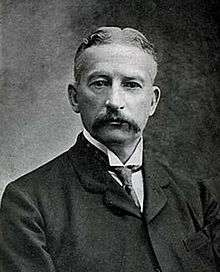William Kenyon-Slaney
 | |||
| Personal information | |||
|---|---|---|---|
| Full name | Colonel the Rt. Hon. William Slaney Kenyon-Slaney | ||
| Date of birth | 24 August 1847 | ||
| Place of birth | Rajkot, Gujarat, British India | ||
| Date of death | 24 April 1908 (aged 60) | ||
| Place of death | Shifnal, Shropshire, England | ||
| Playing position | Forward | ||
| Senior career* | |||
| Years | Team | Apps | (Gls) |
| Oxford University | |||
| ?–1873 | Wanderers | ||
| 1875–1876 | Old Etonians | ||
| National team | |||
| 1873 | England | 1 | (2) |
| * Senior club appearances and goals counted for the domestic league only. | |||
| Personal information | |||||||||||||||||||||||||||
|---|---|---|---|---|---|---|---|---|---|---|---|---|---|---|---|---|---|---|---|---|---|---|---|---|---|---|---|
| Full name | William Slaney Kenyon-Slaney | ||||||||||||||||||||||||||
| Batting style | Right-handed | ||||||||||||||||||||||||||
| Domestic team information | |||||||||||||||||||||||||||
| Years | Team | ||||||||||||||||||||||||||
| 1869 – 1880 | Marylebone Cricket Club | ||||||||||||||||||||||||||
| Career statistics | |||||||||||||||||||||||||||
| |||||||||||||||||||||||||||
| Source: Cricinfo | |||||||||||||||||||||||||||
William Slaney Kenyon-Slaney PC (24 August 1847 – 24 April 1908), was an India-born English sportsman, soldier and politician.
Kenyon-Slaney was born in Rajkot in Gujarat in British India, the son of Captain William Kenyon of the 2nd Bombay Cavalry and Frances Catherine Slaney, daughter of Robert A. Slaney of Shropshire. Upon the death of Robert Slaney in 1862 the Kenyon family inherited the Slaney family estate of Hatton Grange near Shifnal in Shropshire and the Kenyon family name was changed to Kenyon-Slaney.
Kenyon-Slaney was educated at Eton and briefly at Christ Church, Oxford. In November 1867, he left Oxford and received a commission into the 3rd battalion of the Grenadier Guards.
Kenyon-Slaney was a noted sportsman and played first-class cricket for the MCC. He was also a keen association football player playing for Wanderers and was selected to play for England against Scotland in the second ever football international on 8 March 1873, where he scored two goals. Kenyon-Slaney became the first player to score in an international football match as the first international between the two nations in November the previous year had been a goalless draw.
He also took part for the Wanderers on the winning side in the 1873 FA Cup Final and on the losing side for the Old Etonians in the drawn first match of the 1875 Final and both matches of the 1876 Final.
In 1882 under the command of Sir Garnet Wolseley he took part in the Battle of Tel el-Kebir during the Urabi Revolt and was decorated for his efforts. In 1887 he was promoted to Colonel and placed on half pay. He fully retired from the military in 1892.
On 22 February 1887, he married Lady Mabel Selina Bridgeman, daughter of the 3rd Earl of Bradford; they had two children; a daughter Sybil Agnes Kenyon-Slaney (b. 1888) and a son Robert Orlando Rodolph Kenyon-Slaney (b. 1892) who was High Sheriff of Shropshire in 1935.
In 1886 Kenyon-Slaney was elected to Parliament to represent the Newport division of Shropshire for the Conservative Party which he represented until his death (after an attack of gout) in 1908. He was buried at St Andrew's Parish Churchyard, Ryton, Shropshire.
References
- Martin Pugh, ‘Slaney, William Slaney Kenyon- (1847–1908)’, Oxford Dictionary of National Biography, Oxford University Press, Sept 2004; online edn, May 2006 accessed 25 June 2006
- Cricinfo - Players and Officials - William Kenyon-Slaney at content-uk.cricinfo.com
- England Match No. 2 - Scotland - 8 March 1873 - Match Summary and Report at www.englandfootballonline.com
- Colonel the Rt. Hon. William Stanley Kenyon-Slaney - Profile at englandstats.com
- England 4 - 2 Scotland : Match No. 2 - Saturday, 8th March 1873, 3:00pm at englandstats.com
| Parliament of the United Kingdom | ||
|---|---|---|
| Preceded by Robert Bickersteth |
Member of Parliament for Newport 1886 – 1908 |
Succeeded by Beville Stanier |